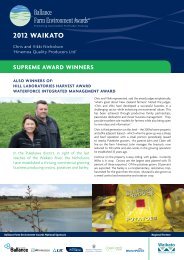Dairy's role in sustaining New Zealand - Fonterra
Dairy's role in sustaining New Zealand - Fonterra
Dairy's role in sustaining New Zealand - Fonterra
Create successful ePaper yourself
Turn your PDF publications into a flip-book with our unique Google optimized e-Paper software.
8 Dairy’s <strong>role</strong> <strong>in</strong> generat<strong>in</strong>g growth<br />
Dairy exports and rural livelihoods<br />
Any <strong>in</strong>quiry <strong>in</strong>to the <strong>New</strong> <strong>Zealand</strong> economy and its work<strong>in</strong>gs has to at some po<strong>in</strong>t focus<br />
on the central driv<strong>in</strong>g force of economic growth: trade. Trade is important because over<br />
time <strong>New</strong> <strong>Zealand</strong>’s spend<strong>in</strong>g must equal its <strong>in</strong>come. Without <strong>in</strong>ternational trade the<br />
<strong>in</strong>come of <strong>New</strong> <strong>Zealand</strong> bus<strong>in</strong>esses is limited by domestic spend<strong>in</strong>g. International trade<br />
removes this limit.<br />
With dairy exports at 26% of goods exports, the impact of the dairy <strong>in</strong>dustry on<br />
economic activity is considerable. The money that farmers spend <strong>in</strong> their communities<br />
and <strong>in</strong> other parts of the country drives further economic activity – the more they earn<br />
on <strong>in</strong>ternational markets the more they spend <strong>in</strong> <strong>New</strong> <strong>Zealand</strong>. Dairy farmers’success is<br />
mirrored not only <strong>in</strong> their local communities but also <strong>in</strong> the cities of <strong>New</strong> <strong>Zealand</strong> which<br />
produce the goods and services that are bought by farmers. Even imports have a local<br />
component s<strong>in</strong>ce they have to be transported to the po<strong>in</strong>t of sale.<br />
Nobody understands this more than the mayors of the districts, regions and cities of <strong>New</strong><br />
<strong>Zealand</strong>. Peter Tennent, Mayor of <strong>New</strong> Plymouth, says that “while the dairy <strong>in</strong>dustry <strong>in</strong> his<br />
region only makes up 2% of the workforce, 100% of the community are the benefactors<br />
of their efforts. When dairy farmers are smil<strong>in</strong>g, the region smiles”. Hugh Vercoe, Mayor of<br />
the Matamata Piako District, also knows how important dairy is to his district: “not only<br />
are we reliant on the dairy [farm<strong>in</strong>g] <strong>in</strong>dustry, we have five dairy process<strong>in</strong>g plants and<br />
very active sale yards. This helps to ma<strong>in</strong>ta<strong>in</strong> a vibrant community”. David Adamson, CEO<br />
of the Southland District Council says that the dairy <strong>in</strong>dustry has “changed the face of<br />
Southland”. He adds that “its economy has weathered the recession well, ma<strong>in</strong>ly because<br />
of the <strong>in</strong>fluence of the dairy <strong>in</strong>dustry”.<br />
In the first <strong>in</strong>stance farmers spend their <strong>in</strong>comes on <strong>in</strong>dustries that directly support<br />
their activities. They buy more cows, upgrade equipment, buy fertilizer, repay debt and<br />
make land improvements. David Adamson suggests that this is the most visible sign<br />
of the impact of dairy growth on the Southland region: “most of the money earned by<br />
farmers is spun out <strong>in</strong>to the community”. S<strong>in</strong>ce most of the goods and services come<br />
from outside of the prov<strong>in</strong>ces, other communities benefit as well. In work done by<br />
NZIER (2003) it is shown that it takes about 18 months for this economic ‘ripple’effect of<br />
additional export revenue to fully work through the <strong>New</strong> <strong>Zealand</strong> economy, all of which<br />
leads to stronger household spend<strong>in</strong>g and bus<strong>in</strong>ess <strong>in</strong>vestment.<br />
What would <strong>New</strong> <strong>Zealand</strong> look like without the dairy <strong>in</strong>dustry? Peter Tennent f<strong>in</strong>ds it<br />
difficult to imag<strong>in</strong>e this situation but one th<strong>in</strong>g he does know is that “<strong>New</strong> Plymouth<br />
would not have been judged the best place to live on the planet by the United Nations<br />
backed Liv.com Awards without the dairy <strong>in</strong>dustry … we’d still be smil<strong>in</strong>g but not as<br />
wide … and there’d be far fewer bus<strong>in</strong>esses here”. Similar sentiments are echoed by<br />
David Adamson and Hugh Vercoe. Both said there would be fewer bus<strong>in</strong>esses, less<br />
vibrant community, and fewer job opportunities. Not only would there be fewer job<br />
opportunities and <strong>in</strong>creased movement of people to the cities, those cities would also be<br />
poorer.<br />
The dairy <strong>in</strong>dustry has had a major impact on <strong>New</strong> <strong>Zealand</strong> society and economy for<br />
over 130 years. Those <strong>in</strong>volved <strong>in</strong> runn<strong>in</strong>g districts and cities closest to the dairy <strong>in</strong>dustry<br />
well understand the positive impact of dairy<strong>in</strong>g, not just on their regions and cities but<br />
on the rest of <strong>New</strong> <strong>Zealand</strong>.
















